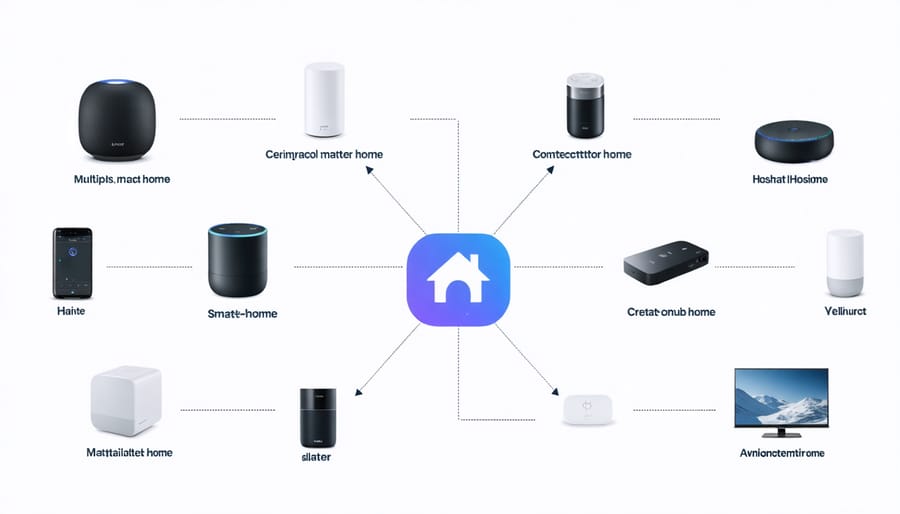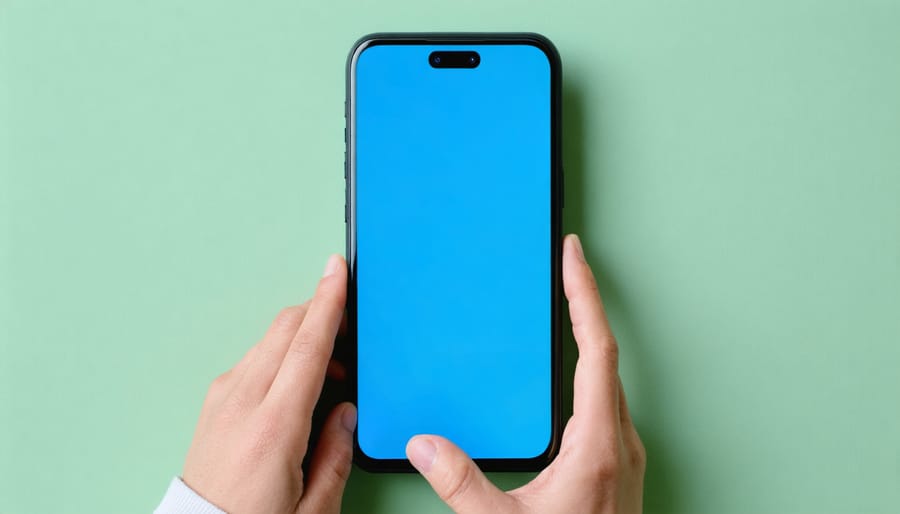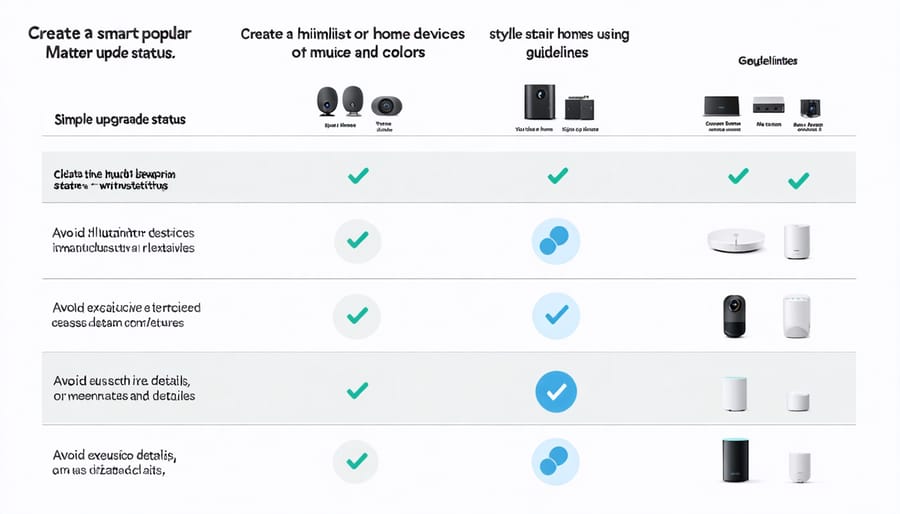Transform your home into a seamlessly connected haven with Matter, the revolutionary protocol reshaping smart home systems. This groundbreaking standard unifies Apple HomeKit, Google Home, Amazon Alexa, and Samsung SmartThings under one universal language, finally ending the fragmentation that has long frustrated smart home enthusiasts.
Imagine controlling every connected device in your home through any platform you choose, without worrying about compatibility issues or multiple apps. Matter’s local communication protocol ensures faster response times and enhanced privacy, while its robust security architecture protects your connected ecosystem from vulnerabilities.
For homeowners ready to embrace the future, Matter represents more than just another smart home protocol – it’s the foundation for a truly intelligent living space where devices from different manufacturers work together seamlessly. Whether you’re starting your smart home journey or upgrading existing devices, Matter’s open-source approach and industry-wide support make it the most promising development in connected home technology since WiFi.
What Makes Matter Different from Previous Smart Home Standards
Universal Device Compatibility
Gone are the days of worrying whether your smart devices will work together. Matter’s universal compatibility is like having a common language that all your smart home devices can speak, regardless of their brand or platform. Whether you’re team Apple, Google, Amazon, or Samsung, Matter-certified devices will work seamlessly with your preferred ecosystem.
Think of it as a universal translator for your smart home. Your Phillips Hue lights can now easily communicate with your Nest thermostat, while your Ring doorbell plays nicely with your Apple HomeKit setup. This means you’re no longer locked into buying devices from a single manufacturer or ecosystem.
The best part? Setting up new devices is incredibly simple. When you bring home a Matter-certified product, it will automatically be recognized by your smart home system. No more complicated pairing processes or frustrating compatibility issues. You can mix and match devices based on features and prices that work best for you, rather than being limited by brand compatibility.
For existing smart home enthusiasts, many current devices will receive Matter support through software updates, making the transition smooth and cost-effective.

Enhanced Security Features
When it comes to home security protection, Matter takes things to the next level with robust encryption and security features built right into its core. Every device that carries the Matter badge must meet strict security standards, giving you peace of mind about your connected home.
Think of Matter’s security like a digital fortress protecting your smart home. It uses advanced encryption methods similar to what banks use, ensuring that your door locks, security cameras, and other sensitive devices can’t be compromised by unauthorized users. Each device gets its own unique “digital fingerprint,” making it nearly impossible for hackers to impersonate your smart home gadgets.
What’s really great is that Matter handles all this security automatically – you don’t need to be a tech expert to stay protected. Software updates happen seamlessly in the background, fixing any potential security issues before they become problems. Plus, local processing means your data stays within your home network, rather than being sent to distant servers.
Setting Up Your Matter-Ready Smart Home
Required Hardware and Controllers
To get started with the new smart home protocol, you’ll need a few key pieces of hardware. First and foremost, you’ll want a Matter-compatible smart home hub, which serves as the central control point for all your connected devices. Popular options include the latest Amazon Echo devices, Apple HomePod Mini, or Google Nest Hub.
For optimal performance, make sure your Wi-Fi router supports 2.4GHz networks, as this is the frequency most smart home devices use. While many newer routers come with built-in Thread border routing capabilities, you might need to add a Thread border router device if yours doesn’t include this feature.
As for controllers, you have several user-friendly options. Your smartphone will be your primary control device, working through apps like Apple Home, Google Home, or Amazon Alexa. These apps serve as your main interface for managing all your smart devices. Many hubs also come with voice control capabilities, letting you manage your smart home hands-free.
For those who prefer physical controls, you might want to consider adding a dedicated smart home control panel or touchscreen display. These wall-mounted devices provide quick access to your most-used functions without reaching for your phone.
Remember that while the new protocol aims to simplify smart home setup, not all existing devices are compatible yet. When shopping for new smart devices, look for the Matter certification logo to ensure they’ll work seamlessly with your system. The good news is that many manufacturers are updating their existing products through firmware updates to support the new protocol.

Step-by-Step Connection Process
Getting your Matter-enabled devices up and running is simpler than traditional smart home automation setup. Here’s how to connect your new Matter devices in just a few easy steps:
1. Download your preferred Matter-compatible app (like Apple Home, Google Home, or Samsung SmartThings) to your smartphone.
2. Ensure your home has a Matter controller device, such as a smart speaker or hub that supports the protocol.
3. Look for the Matter QR code on your new device or its packaging. This unique code contains all the information needed for setup.
4. Open your chosen app and select “Add Device” or a similar option. Most apps will automatically detect when a Matter device is nearby.
5. Use your phone’s camera to scan the Matter QR code when prompted.
6. Follow the in-app instructions to name your device and assign it to a room.
7. Wait for the automatic configuration process to complete – this usually takes less than a minute.
8. Once connected, test the device’s basic functions through the app.
Pro Tips:
– Keep your phone close to the device during setup
– Make sure your Wi-Fi network is stable
– If the QR code scan fails, most devices offer a manual code entry option
– Some devices may require a firmware update before Matter activation
Remember, one of the best features of Matter is that once a device is set up, it can be controlled by any Matter-compatible platform in your home. No need to repeat the process for different ecosystems!
Upgrading Your Existing Smart Home Devices
Which Devices Can Be Updated
The exciting news is that many of your existing smart home devices might be ready for a Matter upgrade through a simple software update. Major brands like Apple, Google, and Amazon have already committed to updating their recent smart speakers and displays. This means your Echo devices from 2018 onwards, Google Nest speakers and displays, and Apple HomePod models are likely eligible for the Matter update.
For smart lighting, Philips Hue Bridge owners can expect a Matter upgrade, making their existing bulbs compatible with the new protocol. Several smart plug manufacturers, including Eve and Belkin WeMo, have also announced Matter updates for their recent models.
However, not all devices will be upgradeable. As a general rule, smart home devices manufactured within the last 2-3 years are more likely to receive Matter support. The best way to check if your device is eligible is to:
1. Check your device’s manufacturing date
2. Visit the manufacturer’s website
3. Look for Matter compatibility in your device’s app settings
4. Contact customer support with your model number
Keep in mind that even if your current devices aren’t Matter-compatible, you don’t need to replace everything at once. You can gradually transition to Matter-enabled devices as you upgrade your smart home setup naturally over time.

When to Replace vs. Update
Making the decision between updating or replacing your smart home devices doesn’t have to be complicated. Here’s a practical guide to help you make the right choice for your home and budget.
Consider updating your existing devices if they’re less than two years old and the manufacturer has announced Matter compatibility through firmware updates. Many leading brands are offering free updates to bring their recent devices into the Matter ecosystem. Check your device’s settings or manufacturer’s website for available updates before making any purchasing decisions.
However, replacement might be your best option if your devices are:
– More than three years old
– Not on the list for Matter updates
– Already showing signs of performance issues
– Using outdated wireless protocols
– Consuming more energy than newer models
Before making your decision, factor in the total cost of ownership. While updating is usually free, newer Matter-compatible devices often offer improved energy efficiency and additional features that could save you money in the long run.
Pro tip: Create a simple inventory of your smart home devices, noting their age, current performance, and update status. This will help you prioritize which devices to update or replace first, allowing you to spread the cost over time while maintaining a functional smart home system.
Future-Proofing Your Smart Home with Matter
As we look ahead, Matter’s role in shaping the smart home landscape becomes increasingly significant. This new protocol isn’t just another fleeting technology trend – it’s laying the groundwork for a truly integrated and hassle-free smart home experience that will evolve with your needs.
One of Matter’s most compelling features is its built-in future-proofing capabilities. When you invest in Matter-certified devices today, you’re essentially preparing your home for tomorrow’s innovations. The protocol is designed to accommodate new features and capabilities through regular software updates, ensuring your smart home stays current without requiring constant hardware replacements.
Looking at the roadmap ahead, Matter is set to expand its device categories significantly. While the initial rollout covers essential devices like lights, switches, and thermostats, future updates will bring support for more sophisticated devices such as cameras, robot vacuums, and future-proof smart energy systems.
Security remains a top priority in Matter’s development. The protocol’s encryption and authentication mechanisms are designed to evolve, protecting your home against emerging cyber threats. This adaptive security approach means your smart home won’t become vulnerable as new security challenges arise.
Perhaps most exciting is Matter’s potential for AI integration. The standardized protocol creates opportunities for more sophisticated automation and learning capabilities. Imagine your home not just responding to commands but anticipating your needs based on your daily routines and preferences.
For those concerned about environmental impact, Matter’s efficiency-focused design helps reduce energy consumption across your smart home network. The protocol optimizes device communication and processing, resulting in lower power usage and extended device life spans.
To make the most of Matter’s future-proofing benefits, consider these practical steps:
– Choose devices from established brands committed to the Matter standard
– Keep your devices’ firmware updated regularly
– Plan your smart home setup with expansion in mind
– Start with core devices and gradually add more as Matter’s capabilities grow
By embracing Matter today, you’re not just solving current smart home challenges – you’re investing in a platform that will continue to deliver value and innovation for years to come.
As we’ve explored, the new smart home protocol represents a significant leap forward in making our homes smarter and more connected than ever before. Matter’s promise of universal compatibility means you can finally mix and match devices from different brands without worrying about compatibility issues. This breakthrough technology is set to transform how we interact with our homes, making smart home adoption more accessible and user-friendly for everyone.
To get started with Matter in your home, begin by checking which of your existing devices will receive Matter updates. Many manufacturers have already announced their commitment to providing firmware updates for compatible devices. Next, consider upgrading your smart home hub if needed, as this will serve as the foundation for your Matter-enabled system.
Remember, while the transition to Matter might take some time, the benefits of enhanced security, improved reliability, and seamless device integration make it worth the wait. Keep an eye on manufacturer announcements and updates, and plan your smart home upgrades accordingly.
Whether you’re just starting your smart home journey or looking to expand your existing setup, Matter’s standardized approach promises to make the process simpler and more enjoyable. Take it one step at a time, and soon you’ll be experiencing the future of home automation exactly as it should be – effortless, reliable, and truly smart.
